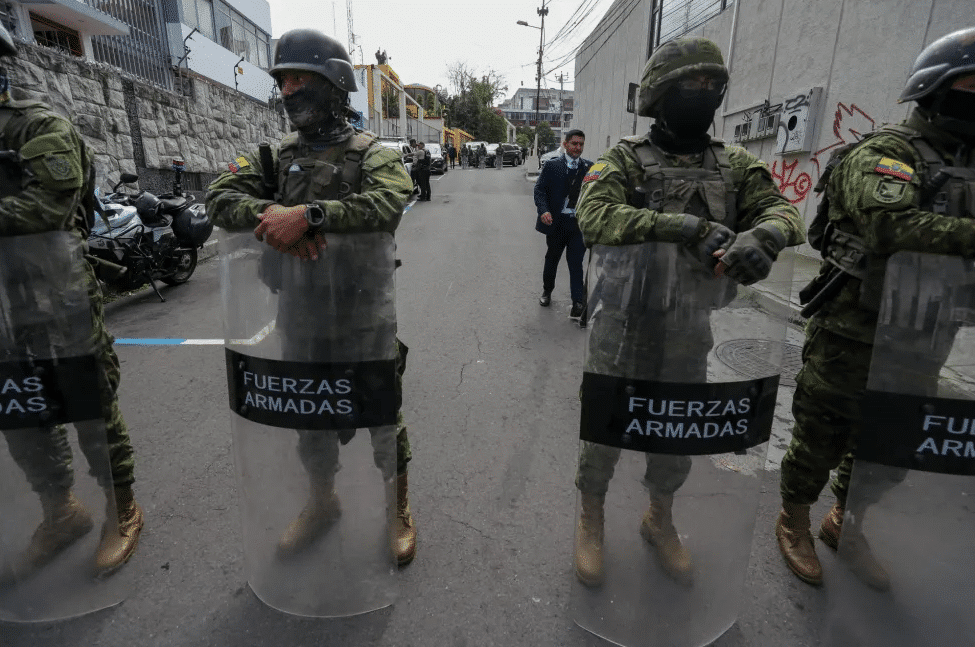
The Return of the Military

PUBLICIDAD 1M
PUBLICIDAD 4D
PUBLICIDAD 5D
Ortega first led Nicaragua after his left-wing Sandinista National Liberation Front (FSLN) overthrew the previous dictatorship in 1979.

Daniel Ortega in the 39th anniversary of the Sandinista Revolution in July, 2018. Photo: Carlos Herrera / Confidencial
The catastrophic collapse of Venezuela has grabbed global headlines, and for good reason. But the coverage has obscured the similarly intense – and closely linked – struggle in nearby Nicaragua.
The Nicaraguan crisis erupted last April, when paramilitary groups loyal to the government – so-called grupos de choque – violently crushed a small protest against just-announced pension reforms. The episode triggered more demonstrations, which were met with more repression, carried out both by grupos de choque and security forces. As the casualties piled up – at least 325 protesters have been killed so far, more than in Venezuela, and another 700 have been jailed – anger at President Daniel Ortega continued to grow.
For now, an opposition group known as the Civic Alliance for Justice and Democracy (ACJD) is engaged in dialogue with the Ortega government, in the hopes of negotiating a peaceful resolution to the crisis. The negotiations have already broken down once, soon after they were first launched in May 2018. But this past February, at Ortega’s request, they were resumed.
The ACJD – and, indeed, the protesters – have set their sights far higher than stopping the pension reform. They are demanding deep democratic reforms aimed at guaranteeing free and fair elections, freedom for those who have been arrested during the protests, and justice for those who were killed.
Ortega seems most willing to fulfill the demand to release jailed protesters. In February, the government released 100, but they were immediately placed under house arrest, leaving the ACJD unsatisfied. Then, in March, police detained another 100 protesters, spurring the ACJD to suspend talks. Now, in a bid to get the process back on track, the Nicaraguan government has pledged to release all opposition prisoners within 90 days.
The ACJD’s other demands are much farther from being fulfilled. The call for justice could prove to be a major sticking point in negotiations. As for democratic reforms, Ortega has already ruled out an early election – another factor that caused talks to break down previously – claiming that it would amount to a coup d’état. His ability to hold onto power, however, will be partly determined by events in Venezuela.
Ortega first led Nicaragua after his left-wing Sandinista National Liberation Front (FSLN) overthrew the previous dictatorship in 1979. In 1985, after serving for six years as Coordinator of the Junta of National Reconstruction, Ortega took over the presidency.
Throughout the “Sandinista revolution,” Nicaragua suffered grievously from a brutal war. In an effort to overthrow the FSLN, the United States financed, trained, and armed Nicaraguan rebels, known as the Contras. More than 30,000 Nicaraguans died in that conflict.
The war finally ended in 1990, because the Sandinistas lost their external support, which had been funneled through Cuba from the Soviet Union, and because the US Congress cut off funding for the Contras. Ortega was defeated in the first election since the revolution, held that February.
Soon, Nicaragua – once the second-poorest state in the Americas (after Haiti) – was prospering. Beginning in the early 1990s, economic growth picked up, averaging 4-5% annually until 2018. While the country remains poor, a significant number of Nicaraguans have joined the middle class.
Moreover, Nicaragua largely escaped the scourge of gang violence that afflicts other Central American countries, including El Salvador, Guatemala, and Honduras. With the crime rate reasonably low, relatively few Nicaraguans fled to the North.
But Nicaragua’s fortunes would soon begin to change. Once the FSLN was out of power, many of its more democratically minded members broke away, creating the Sandinista Renovation Movement. The hard-left FSLN that was left behind centered on Ortega and his wife, Rosario Murillo (now Nicaragua’s vice president).
In 2006, after multiple failed attempts, Ortega recaptured the presidency with just 38% of the vote, thanks to a much-criticized pact (“El Pacto”) with another political party to change the electoral law so that only a plurality was needed. He was elected to another five-year term in 2011.
In 2016, after the National Assembly abolished term limits, Ortega won by an even wider margin, though no one could confirm the numbers he claimed, because he banned international observers. It was in this election that Murillo became vice president, a post she has used to position herself as Ortega’s political successor.
As president, Ortega has nurtured ties with repressive regimes in Iran, Libya, and, perhaps most important, Venezuela. Flush with money as a result of high oil prices, Hugo Chávez, the architect of Venezuela’s own left-wing revolution, and, later, Chávez’s hand-picked successor, Nicolás Maduro, could channel substantial funding to their ally in Nicaragua – some $3.7 billion from 2008 to 2015, according to a recent estimate. There was little transparency regarding how Ortega’s government spent this money. By the time the 2016 election was held, Ortega’s family controlled several television stations.
Then Venezuela’s economy collapsed, funding dried up, and Nicaragua’s economy began to suffer, stoking the discontent that led to last year’s protests. Since then, Nicaragua’s economy Since then Nicaragua’s GDP has shrunk by about 4% in total.
But while Venezuela is not providing cash to Ortega, it is still providing a distraction. If the Maduro government falls, international attention will likely shift to Nicaragua, and the pressure on Ortega and Murillo to step down will probably intensify. Just as the previous strength of Venezuela’s chávistas buttressed Ortega’s position, their current weakness may well be his undoing.
Aryeh Neier, President Emeritus of the Open Society Foundations and a founder of Human Rights Watch, is the author of The International Human Rights Movement: A History.
Copyright: Project Syndicate, 2019.
www.project-syndicate.org
Archivado como:
PUBLICIDAD 3M
PUBLICIDAD 3D